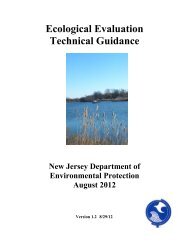Technical and Regulatory Guidance for In Situ Chemical ... - ITRC
Technical and Regulatory Guidance for In Situ Chemical ... - ITRC
Technical and Regulatory Guidance for In Situ Chemical ... - ITRC
Create successful ePaper yourself
Turn your PDF publications into a flip-book with our unique Google optimized e-Paper software.
<strong>ITRC</strong> – <strong>Technical</strong> <strong>and</strong> <strong>Regulatory</strong> <strong>Guidance</strong> <strong>for</strong> <strong>In</strong> <strong>Situ</strong> <strong>Chemical</strong> June 2001<br />
Oxidation of Contaminated Soil <strong>and</strong> Groundwater<br />
technologies, such as ISCO, are employed. Site-specific complexities <strong>and</strong> the nuances of specific<br />
technologies dem<strong>and</strong> that a more in depth analysis of at least feasibility, if not optimization, be<br />
conducted. Site-specific technology feasibility testing is typically conducted during the remedial<br />
investigation or a subsequent technology-screening phase, while optimization testing is typically<br />
conducted during the engineering feasibility or early design stages.<br />
Technology feasibility testing is typically first conducted at the laboratory scale, commonly referred<br />
t o as a treatability study. Site materials (e.g., soil <strong>and</strong> groundwater) are properly packaged <strong>and</strong><br />
shipped to the laboratory facility. Measurement of critical physical <strong>and</strong> chemical parameters is<br />
conducted <strong>and</strong> the resulting measurement data are reviewed to determine general suitability of the<br />
technology <strong>and</strong> to identify issues that may require further investigation. Typically, the bench-scale<br />
t est ing results are used to complete technology selection <strong>and</strong> to prepare <strong>for</strong> a field test of the<br />
technology at the site in question. Occasionally, the bench-scale testing is deemed adequate to<br />
support full-scale design <strong>and</strong> no further testing is per<strong>for</strong>med. <strong>In</strong> this situation, the bench-scale testing<br />
has not only addressed the issue of technology applicability, but has also generated in<strong>for</strong>mation to<br />
allow a measure of full-scale optimization.<br />
Optimization testing is ty p ically conducted in the field setting at what is referred to as the pilot scale.<br />
Pilot studies are conducted at a scale that is commensurate with a more comprehensive analysis of<br />
technology effectiveness <strong>and</strong> testing of optimization schemes. ISCO technology vendors may choose<br />
to per<strong>for</strong>m pilot-scale testing as the initial step towards full-scale design <strong>and</strong> implementation if site<br />
<strong>and</strong> contaminant features are believed to be adequately represented in their experience base. Fullscale<br />
design typically follows pilot testing, although on occasion the pilot study results in the<br />
discovery of unique <strong>and</strong> adverse site features that cause a specific technology to be rejected.<br />
The results of bench-scale testing of an ISCO technology may or may not be directly (linearly)<br />
applied to the design of a corresponding pilot-scale study. The same may be said <strong>for</strong> pilot studies as<br />
they relate to full-scale design. The process of nonlinear scaling up of the results from a small scale<br />
to a larger scale may be required. Scaling up is usually applicable to bench-scale studies while pilotscale<br />
studies are often per<strong>for</strong>med at a scale that is essentially the same as the full system under<br />
consideration. Bench-scale results are often based on extremely small volumes of disturbed soil<br />
<strong>and</strong>/or groundwater relative to the volume that requires treatment. The test apparatus may not<br />
adequately recreate the geometric nature or flow characteristics of the physical system observed in<br />
t he field. For example, one-dimensional flasks or columns <strong>and</strong> two-dimensional tanks are often<br />
utilized as convenient means to simulate the three dimensional environment. Often the dimensions<br />
of the apparatus are such that test boundary conditions (e.g., wall effects) that are not present in the<br />
field become important. Also, bench-scale tests often are based on well mixed static systems while<br />
the field implementation involves dynamic plug flow. Additional discussion on laboratory- (bench-),<br />
pilot-, <strong>and</strong> full-scale demonstration of an ISCO technology can be found in Greenberg, et al., 1998,<br />
<strong>and</strong> in Siegrist, et al., 2000. Although a few sophisticated tools have been developed <strong>and</strong> applied<br />
against ISCO field data with success (Zhang <strong>and</strong> Schwartz, 2000), it is anticipated that these tools<br />
will not be applied on a regular basis to ISCO applications <strong>for</strong> several more years.<br />
Objectives of bench-scale studies of ISCO technologies as a group, or technical considerations that<br />
should be addressed in planning <strong>for</strong> bench-scale testing, are listed in Table 2-2.<br />
TABLE 2-2<br />
ISCO Bench-Scale Studies<br />
1. Isolate one or more physical or chemical processes to assess basic feasibility of the technology<br />
(e.g., remove rate-limiting transport processes by establishing a well-mixed system <strong>for</strong><br />
evaluating basic chemical compatibility).<br />
8
















